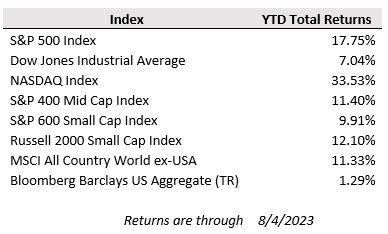A wobble in fixed income markets last week injected some caution back into the U.S. equity market following a sharp year-to-date rally as a downgrade of the U.S. credit rating from its AAA-status to AA+ by Fitch triggered a sudden rise in market interest rates. For the week, the S&P 500 declined by 2.3%, the Nasdaq fell 2.9%, and the Dow Jones lost 1.1%. The equity sell-off gained steam as the 10-year U.S. Treasury yield broke above 4% and approached levels not seen since November of the previous year following Fitch’s downgrade Tuesday evening.
The backup in interest rates serves as a bit of a wakeup call that places higher scrutiny on U.S. equity market valuations, which have risen notably this year with improving sentiment from AI enthusiasm, moderating inflation, and economic resilience. Rising interest rates can pose a headwind to equity markets in some cases as a higher discount rate reduces the present value of future earnings, and safer, higher yielding bonds become more appealing as an investment alternative relative to higher-risk assets like equities. Additionally, rising interest expenses can cut into profit margins, slow investment activity, and increase the risk of failure for highly leveraged businesses.
The timing of the Fitch downgrade came as a bit of a surprise to market participants coming two months after the resolution of the debt ceiling dispute in early June. In its rating report rationale, the credit agency cited "expected fiscal deterioration over the next three years, a high and growing general government debt burden, and the erosion of governance relative to 'AA' and 'AAA' rated peers". Fitch’s U.S. credit rating now aligns with S&P Global which downgraded the U.S. to AA+ back in August of 2011, though Moody’s still rates the U.S. as AAA.
Despite the downgrade, U.S. economic activity has continually surprised to the upside this year, especially the labor market. On Friday, the Bureau of Labor Statistics released the July jobs report, which indicated a nonfarm payrolls increase of 187k, slightly below the consensus forecast of 200k and lower than May's gain of 281k. The unemployment rate dropped from 3.6% to 3.5%. Wages came in hotter than expected, rising 0.4% during the month, or 4.4% year-over-year.
The jobs report presented a mixed bag for the Federal Reserve. While it showed continued cooling of job gains, the low unemployment rate and sticky wage inflation demonstrated persistent tightness in the labor market. This tightness may exert pressure on inflation, making it a critical factor for the central bank to monitor in its decision-making.
In the week ahead, market participants will be closely monitoring the inflation data with the release of the Consumer Price Index (CPI) on Thursday. Given the tight labor market and recent rebound in oil and gas prices, investors are keen to gauge how well the recent trends in moderating inflation can be maintained. Notably, U.S. gasoline prices have risen nearly 10% in the past month, and the high prior year energy price comparisons (oil prices peaked in June of 2022) have started to fall, thereby biasing the year-over-year growth rate higher.
On the corporate earnings front, second quarter earnings season is beginning to wind down following a busy week with approximately 85% of the S&P 500 companies having reported their results. According to FactSet, the index is on track for a -5% year-over-year growth rate (or +1.1% excluding energy stocks), compared to an expected decline of closer to -6% at the start of earnings season. The positive takeaways from quarterly reports have revolved around consumer resilience, strong growth narratives in big tech, and favorable trends in various industries like auto, industrial, and commercial aerospace. However, there have also been several points of caution including potential negative operating leverage risks due to waning pricing power, wage pressures, freight recession, and softening U.S. travel demand. Investors continue to pay close attention to forward guidance from companies and how well they navigate these various themes amid the current economic environment.



